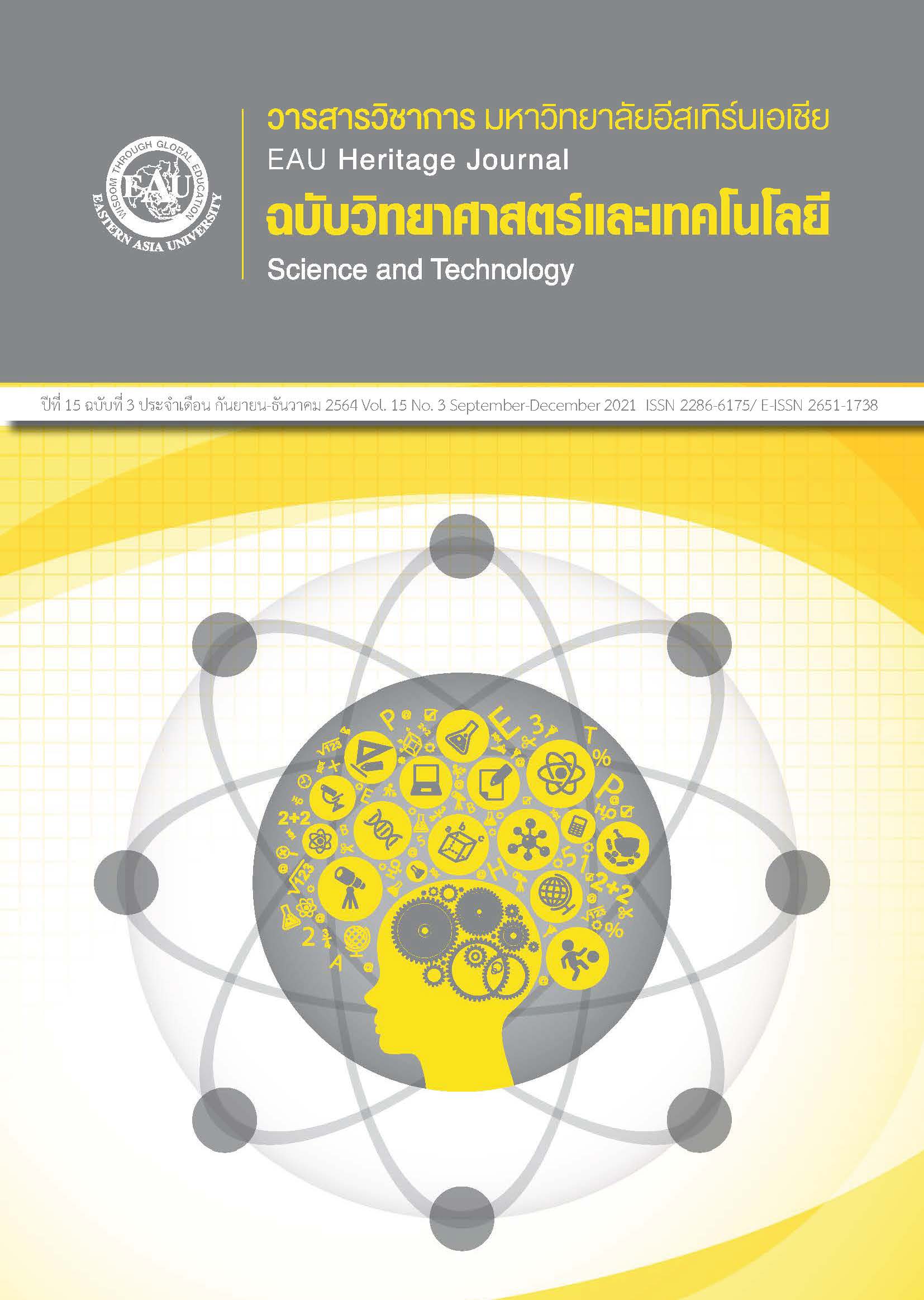ผลิตภัณฑ์อาหารเพื่อสุขภาพจากรำข้าวของวิสาหกิจชุมชนกลุ่มอนุรักษ์ชาวนาหัวหินตำบลทับใต้ อำเภอหัวหิน จังหวัดประจวบคีรีขันธ์
คำสำคัญ:
การพัฒนาผลิตภัณฑ์; อาหารเพื่อสุขภาพ; ผลิตภัณฑ์รำข้าวไรซ์เบอรี่; ขนมปัง; คุกกี้บทคัดย่อ
งานวิจัยนี้วัตถุประสงค์เพื่อพัฒนาผลิตภัณฑ์อาหารเพื่อสุขภาพจากรำข้าวและประเมินความพึงพอใจของผู้บริโภคที่มีต่อผลิตภัณฑ์อาหารเพื่อสุขภาพที่ได้รับการพัฒนาขึ้นโดยการนำรำข้าวไรซ์เบอร์รี่มาทดแทนแป้งสาลีในผลิตภัณฑ์ขนมปังหวานและคุกกี้เนยสดที่ระดับร้อยละ 0 5 10 และ 15 เพื่อศึกษาคุณลักษณะของผลิตภัณฑ์ในด้านลักษณะปรากฏ สี กลิ่น รสชาติ เนื้อสัมผัส และความชอบรวม ทำการประเมินคุณภาพทางประสาทสัมผัส ด้วยวิธีการให้คะแนนความชอบ 9-Point Hedonic Scale กับผู้ทดสอบชิม จำนวน 50 คน และประเมินความพึงพอใจของผู้บริโภคที่มีต่อผลิตภัณฑ์ จำนวน 100 คน วิเคราะห์ข้อมูลโดยใช้ค่าความถี่ ร้อยละ ค่าเฉลี่ย ส่วนเบี่ยงเบนมาตรฐาน วิเคราะห์ความแปรปรวนที่ระดับความเชื่อมั่น 95 % และวิเคราะห์ความแตกต่างของค่าเฉลี่ยด้วยวิธี Duncan’s New Multiple Range Test ผลการวิจัยพบว่า สูตรขนมปังหวานที่ทดแทนแป้งสาลีด้วยรำข้าวไรซ์เบอร์รีที่ระดับ ร้อยละ 10 ได้รับคะแนนความชอบใกล้เคียงกับสูตรควบคุมมากที่สุด และกลิ่นของขนมปังหวานทั้ง 4 สูตรไม่มีความแตกต่างอย่างมีนัยสำคัญทางสถิติ (p>.05) คะแนนความชอบของคุกกี้เนยสดที่ใช้รำข้าวไรซ์เบอร์รีมาทดแทนแป้งสาลีทั้ง 4 สูตร เกือบทุกด้านไม่แตกต่างกัน ยกเว้น ด้านสีที่มีความแตกต่างกันกับสูตรควบคุมอย่างมีนัยสำคัญทางสถิติ (p<.05) นอกจากนี้ ยังพบว่า ผู้บริโภคมีความพึงพอใจต่อขนมปังหวานในระดับชอบมาก ส่วนคุกกี้เนยสดอยู่ในระดับชอบมากถึงมากที่สุด โดยผู้บริโภค ร้อยละ 99 ยอมรับผลิตภัณฑ์ขนมปังหวานและคุกกี้เนยสดจากรำข้าวไรซ์เบอร์รี่ เพราะเห็นว่าได้คุณค่าทางอาหารเพิ่มขึ้น ผู้บริโภค ร้อยละ 71 สนใจซื้อผลิตภัณฑ์ที่ร้านเบเกอรี่ ในราคาถุงละ 10-20 บาท และกล่องละ 30-35 บาท ผลการวิจัยแสดงให้เห็นว่าผลิตภัณฑ์ที่พัฒนาขึ้นจากผลผลิตเหลือใช้จากการสีข้าวสามารถสร้างรายได้ให้กับวิสาหกิจชุมชนและเพิ่มทางเลือกอาหารเพื่อสุขภาพให้กับผู้บริโภค
เอกสารอ้างอิง
Anprung, P. (2014). The Principles of sensory simulation for food analysis (3rd ed.). Bangkok: Chulalongkorn University. (in Thai)
Buranathai, S. (2015). Effect of hot air drying conditions on chemical properties and quality of cold-pressed rice bran oil of Khao Gaw Diaw Rice (Master’s thesis). Naresuan University. Phitsanulok. (in Thai)
Changsingha, P. (2012). Population and sample unit 4: The teaching series documents of statistics and research on food and nutrition. Nonthaburi: Sukhothai Thammathirat University. (in Thai)
Chirattiyangkur, A., & Sukthang, N. (2007). A rice bran heat-treatment device for storages. Thai Society of Agricultural Engineering Journal, 13(1), 10-15. (in Thai)
Food Intelligence Center Thailand. (2015). Bakery products in Thailand. Retrieved from http://fic.nfi.or.th/MarketOverviewDomesticDetail.php?id=77 (in Thai)
Issara, U. (2015). Instant and pasteurized organic rice bran milk (Master’s thesis). Mae Fah Luang University. Chiang Rai. (in Thai)
Kuforiji, A. O., Samuel, J., & Sule, A. B. (2017). Effect of addition of rice bran on the physico-chemical and sensory prosperities of wheat bread. International Journal of Advanced Academic Research, 3(10), 1-7. https://www.ijaar.org/articles/Volume3-Number10/Sciences-Technology-Engineering/ijaar-ste-v3n6-jn17-p5.pdf
Lee, D., Kim, M. J., Kwak, H. S., & Kim, S. S. (2020). Characteristics of bread made of various substitution ratios of bran pulverized by Hammer Mill or Jet Mill. Foods (Basel, Switzerland), 9(1), 48. https://doi.org/10.3390/foods9010048
Mishra, N. (2017). Utilization of waste defatted rice bran in formulation of functional cookies and its effect on physiochemical characteristic of cookies. International Journal of Advanced Science and Research, 2(5), 64-68. https://bit.ly/3n0HkjE
Noonim, P. (2004). Effect of processing conditions on aroma quality of rice bran Protein concentrate powder (Master’s thesis). Kasetsart University. Bangkok. (in Thai)
Rania, E. E., Rabie, M. A., El Bana, M. A., & Saleh, M. E. N. (2018). Processing Cookies from defatted thermal stabilized black rice bran. Journal Food and Dairy Science, 2018, 1-5. doi: 10.21608/JFDS.2018.77744
Ratanapan, B., Singkong, W., Haris, A., & Prikboonchan, P. (2017). Development of from Homnin Rice Bran. 2nd National Academic Conference (pp. 233-239). Kanchanaburi: Kanchanaburi Rajabhat University. (in Thai)
Raungrusmee, S., Jadwong, K., & Wongtong, O. (2018). Development of Sandwich formulation substituted wheat flour with Riceberry Rice Bran. Phranakhon Rajabhat Journal of Science and Technology, 13(1), 123-138. (in Thai)
Rawdkuen, S., & Wongsakul, S. (2014). Production of Protein Isolates from organic rice bran by using organic processing compared with conventional methods (Research report). Chiang Rai: Mea Fah Luang University. (in Thai)
Rice Science Center. (2021). Riceberry. Retrieved from http://dna.kps.ku.ac.th/index.php/research-develop/rice-breeding-lab/riceberry-variety (in thai).
Sapantupong, S. (2019). Development of bread with Riceberry Rice Bran. RMUTP Research Journal, 13(2), 186-195. (in thai)
Silanoi, L., & Chindaprasert, K.(2019). The use of rating scale in quantitative research on Social Sciences, Humanities, hotel and Tourism Study. Journal of Management Science, Ubon Ratchathani University. 8(15), 112-126. (in Thai)
Singh, R., Mehra, R., Walia, A., Kumar, H., Gupta, S., & Kumar, N. (2020). Sensory and nutritional qualities of Multi-Grain Cookies supplemented with different level of rice bran. Food and Agriculture Spectrum Journal, 1(4), 1-3. https://fasj.org/index.php/fasj/article/view/31/27
Sirikul, A. (2010). Chemical compositions and antioxidant activity of organic and chemical rice bran (Master’s thesis). Mahasarakham University. Mahasarakham. (in Thai)
Sukamolson, S. (2017). Priori and Posteriori Comparisons for a research study. Academic Journal of Buriram Rajabhat University, 9(2), 51-70. (in Thai)
Taghinia, P., Ataye-Salehi, E., & Sheikholeslami, Z. (2015,). Impact of pretreated rice bran on wheat dough performance and barbari bread quality. Journal of Agricultural Science and Technology, 17, 135-144. https://jast.modares.ac.ir/article-23-8067-en.pdf
Triratanasirichai, K., & Rawdkuen, S. (2012). Rice bran: Form pork food to food for health of people. Retrieved from http://archive.mfu.ac.th/school/agro2012/events/298. (in Thai)
Thi-on, S., & Supavitipatana, P. (2011). Development Sandwich Bread using partial replacement wheat flour with rice bran. Naresaun Agricultural Journal, 13(1), 1-9. (in Thai)
Thongtan, J., & Phupong, W. (2017). The application of Red Jasmine Rice Bran Oil and its extracts for skincare. VRU Research and Development Journal Science and Technology, 12(2), 43-56. (in Thai)
Vanichbuncha, K. (2006). Research statistics (2nd ed.). Bangkok: Department of statistics. Faculty of commerce and Accountancy, Chulalongkorn University. (in Thai)
Wong-arun, W. (2019). Teaching materials of Pastry in hotel. Prachuap Khiri Khan: Rajamangala University of Technology Rattanakosin. Wang Klaikangwon Campus. (inThai)
Younas, A., Bhatti, M. S., Ahmed, A., & Randhawa, M. A. (2011). Effect of rice bran supplementation on Cookie baking quality. Pakistan Journal of Agricultural Sciences, 48(2), 133-138. http://pakjas.com.pk/papers/1934.pdf







